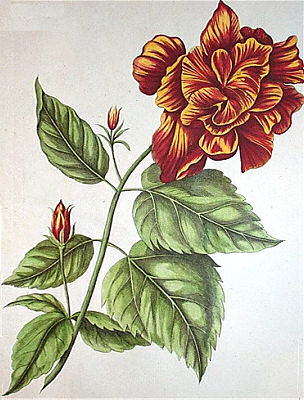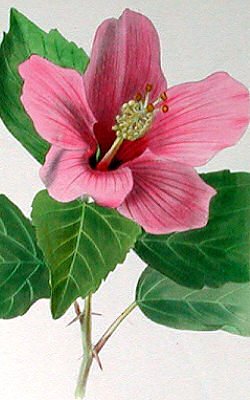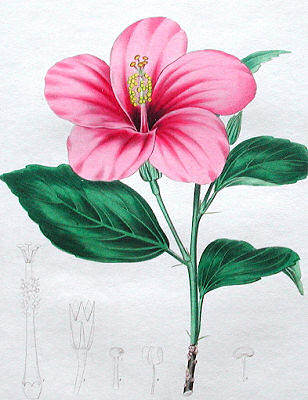
 |

Hibiscus -just the name paints up a picture of tropical sun, deep blue pacific waters and colorful blooms. Although this is true for the widely famous Hibiscus rosa-sinensis L. the genus is wide and varied, consisting of around 250 different species, not all tropical as native hibiscus species are represented on all continents except Antarctica. Some of these species are annual or perennial herbs while others are flowering shrubs or small trees. The common traits are: Short-lived showy five petal flowers, most only last for a day or two, with prominent staminal columns and lobed leaves with proper stems. We shall concentrate on a small section within this large genus called Lilibiscus by botanists. Lilibiscus are a group of tender hibiscus shrubs native to coastal areas surrounding the tropical waters of the Pacific and Indian Oceans, roughly between the east coast of Africa to Hawaii. The group contains around a dozen species, all with rather flashy blooms, that are closely enough related to crossbreed freely. How they once developed is unknown as a prehistoric common ancestor to the lilibiscus is yet to be found. |
 |
 | Tropical Hibiscus is a Lilibiscus!The first hibiscus of the lilibiscus section to make it to the Western world was the double red. This is the variety described by Rumphius (Georg Eberhard Rumpf, 1628 - 1702) and van Rheede (Hendrick Adriaan van Rheede tot Draakenstein, 1637 - 1692), although neither is known to have shipped any plant material to Europe, and subsequently named Hibiscus rosa-sinensis by Linnaeus (Carl von Linné, 1707–1778) based on herbarium species. Lilibiscus of the other species in the group, showing single (5 petal) flowers, were unknown in Europe at the time. Whether the fancy hibiscus really is a native of China as its Latin name Hibiscus rosa-sinensis (rosa-sinensis = Chinese Rose) suggests, or not, we do not know. Some says it comes from India, others Malaysia, or any of the many islands in the Indonesian group. Certain is that H. rosa-sinensis is a tropical plant that people in temperate zones can only grow indoors. Fortunately for us, hibiscus is an excellent potted plant that thrive in room temperature and over a hot radiator in the winter, as it almost appears to want warmth more than light. |
Hybrid ConfusionSince the double red was the first species to be identified, this is important, all crosses between it and other lilibiscus species therefore carries the H. rosa-sinensis label as do all their offspring. This doesn't mean that H. rosa-sinensis is not a true species similar to H. liliflorus or H. arnottianus. It only means that a cross between H. rosa-sinensis and H. liliiflorus will be known as H. rosa-sinensis since that species was named first under the universally adopted Linnean system way back in 1753. Or, to illustrate, a cross between H. arnottianus (name established 1854) and H. liliiflorus (name established 1785) would be called H. liliiflorus. However, if you were to cross this H. liliiflorus hybrid with H. rosa-sinensis the resulting plant would be known as H. rosa-sinensis even though it's really H. rosa-sinensis x arnottianus x liliiflorus. Naming varieties obtained through crossbreeding simplifies matters considerably. You notice hybrid names by the single qoutation marks surrounding them, i. e. H. rosa-sinensis 'Brilliant'. |
 |
This web site is intended as an introduction for those who want to grow tropical hibiscus indoors. Although much of the advice for growing potted hibiscus is general, it is my intention to principally deal with the growing of hibiscus in a regular apartment or house. For information relating to greenhouse and outdoor growing I refer you to the link page. I hope you will enjoy your visit. Come back soon! Illustrations (from top): | |